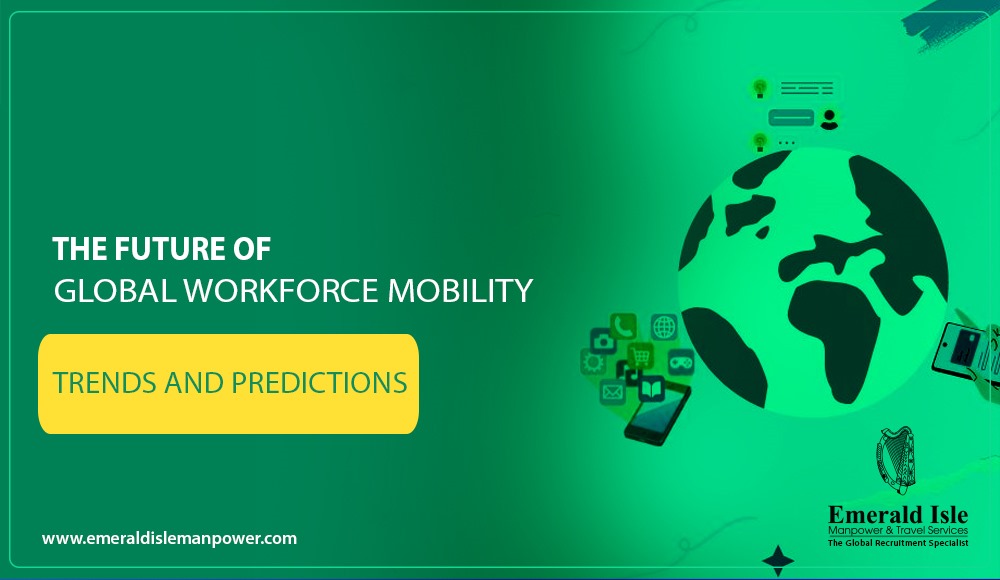Introduction
The concept of global workforce mobility is evolving rapidly. This shift is driven by advances in technology, changes in economic dynamics, and shifting cultural attitudes towards work and life. Understanding the trends and predictions shaping this landscape is crucial. This blog explores key factors influencing global workforce mobility, including technological innovations, economic shifts, policy changes, and cultural transformations.
Technological Innovations
Remote Work Technologies
The COVID-19 pandemic accelerated the adoption of remote work technologies. Tools like Zoom, Microsoft Teams, and Slack have shown that many jobs can be performed from anywhere.
Prediction: The continued refinement of these technologies, including advancements in virtual reality (VR) and augmented reality (AR), will further facilitate remote work, allowing for more immersive and interactive virtual work environments.
Artificial Intelligence and Automation
Artificial Intelligence (AI) and automation are transforming work by taking over repetitive tasks. They also change the demand for certain types of jobs. AI can enhance global workforce mobility by providing data-driven insights and streamlining administrative tasks related to international employment.
Prediction: As AI and automation become more sophisticated, the demand for highly skilled workers will increase. Consequently, this will lead to more cross-border movement of such talent.
Economic Shifts
Emerging Markets
Emerging markets in Asia, Africa, and Latin America are becoming significant players in the global economy. These regions offer new opportunities for businesses and employees alike, driven by growing consumer bases and improving infrastructure.
Prediction: Professionals will increasingly seek opportunities in these emerging markets. As a result, this will lead to a more diverse and interconnected global workforce.
Gig Economy
The gig economy is characterized by short-term contracts and freelance work. Platforms like Upwork, Freelancer, and Fiverr enable workers to find gigs worldwide, thus increasing their mobility.
Prediction: The gig economy will continue to expand, offering more flexible work arrangements. Hence, this will enable professionals to work from multiple locations or countries without being tied to a single employer.
Policy Changes
Immigration Policies
Immigration policies are crucial in shaping global workforce mobility. Countries are recognizing the need to attract skilled workers to boost their economies. Therefore, policies that streamline visa processes and offer incentives for high-skilled immigrants are becoming more common.
Prediction: More countries will adopt favorable immigration policies to attract global talent, making it easier for professionals to move and work internationally.
Remote Work Visas
In response to the rise of remote work, several countries have introduced remote work visas. These allow foreign nationals to live in one country while working for an employer in another.
Prediction: The popularity of remote work visas will grow. Thus, more countries will offer these options to attract digital nomads and remote workers, contributing to greater global workforce mobility.
Cultural Transformations
Work-Life Balance
The concept of work-life balance is evolving as employees seek more flexibility. This shift drives the demand for remote work and flexible schedules. It allows individuals to work from different locations worldwide.
Prediction: Companies will increasingly adopt policies that support flexible work arrangements. Consequently, this will promote a healthier work-life balance and enhance global workforce mobility.
Diversity and Inclusion
There is a growing emphasis on diversity and inclusion within the workplace. Companies are recognizing the value of a diverse workforce that brings different perspectives and ideas.
Prediction: Efforts to promote diversity and inclusion will lead to increased global mobility. Thus, companies will actively seek to hire and relocate talent from diverse backgrounds.
Future Trends
Hybrid Work Models
Global Workforce Mobility and Hybrid Work Models
Hybrid work models combine remote and on-site work. This model offers the flexibility of remote work while maintaining the benefits of in-person collaboration.
Prediction: Hybrid work models will become the norm for many companies. Therefore, this will allow employees to work from different locations part-time, thus enhancing their mobility.
Talent Marketplaces
Global Workforce Mobility Through Talent Marketplaces
Digital talent marketplaces connect employers with a global pool of freelancers and remote workers. These platforms are transforming how companies find and hire talent, breaking down geographical barriers.
Prediction: The rise of digital talent marketplaces will facilitate greater workforce mobility. This will make it easier for professionals to find work opportunities worldwide.
Skills-Based Hiring
Skills-Based Hiring and Global Workforce Mobility
Employers are increasingly focusing on skills-based hiring rather than traditional qualifications. This approach values practical experience and specific skills over degrees and certifications.
Prediction: Skills-based hiring will promote global workforce mobility. As a result, this will allow talented individuals to secure jobs based on their abilities, regardless of their location or educational background.
Employee Experience
Enhancing Employee Experience for Global Workforce Mobility
As competition for top talent intensifies, companies are placing greater emphasis on the employee experience. This includes offering support for relocation, career development opportunities, and a positive work culture.
Prediction: Enhancing the employee experience will become a priority for companies. They will invest more in programs that support workforce mobility to attract and retain global talent.
Sustainable Mobility
Sustainable Mobility in Global Workforce Mobility
Sustainability is becoming a key consideration in global workforce mobility. Companies and employees are looking for ways to reduce their carbon footprint. This includes minimizing travel and utilizing environmentally friendly practices.
Prediction: There will be a greater focus on sustainable mobility solutions. Virtual collaboration tools and eco-friendly travel options will support a greener approach to global workforce mobility.
Conclusion
The future of global workforce mobility is being shaped by a combination of technological innovations, economic shifts, policy changes, and cultural transformations. As remote work technologies advance, emerging markets grow, and immigration policies evolve, the opportunities for professionals to work internationally will expand. The increasing emphasis on work-life balance, diversity and inclusion, and the employee experience will further drive this trend.
Companies that adapt to these changes and embrace the benefits of a mobile, global workforce will be better positioned to attract and retain top talent. By understanding and leveraging these trends and predictions, organizations can create a more dynamic and inclusive work environment. This will support the growth and development of their employees, regardless of where they are in the world.
In conclusion, the future of global workforce mobility promises to be more interconnected, flexible, and inclusive. Professionals and employers alike must stay informed and adaptable to thrive in this evolving landscape. The ability to work and collaborate across borders will become essential for career growth and organizational success.








